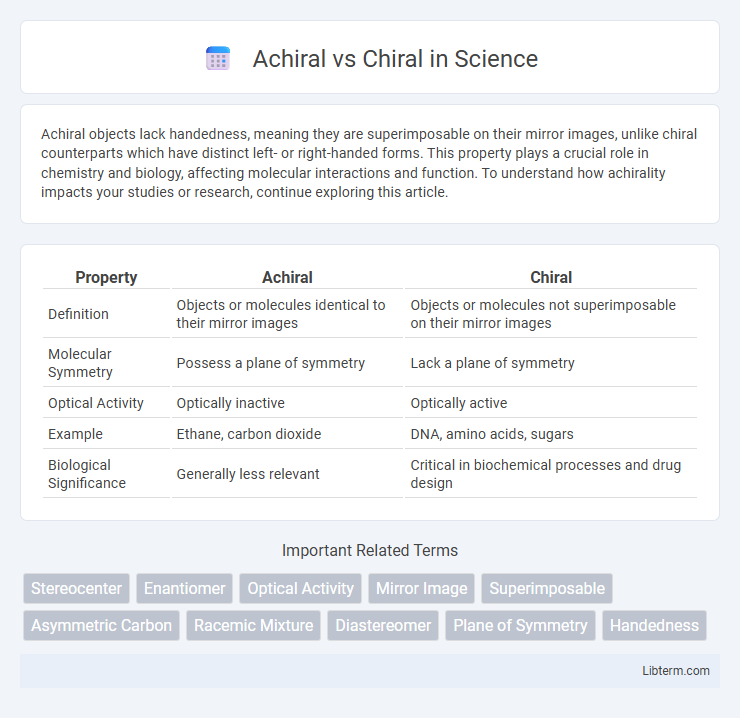Achiral objects lack handedness, meaning they are superimposable on their mirror images, unlike chiral counterparts which have distinct left- or right-handed forms. This property plays a crucial role in chemistry and biology, affecting molecular interactions and function. To understand how achirality impacts your studies or research, continue exploring this article.
Table of Comparison
| Property | Achiral | Chiral |
|---|---|---|
| Definition | Objects or molecules identical to their mirror images | Objects or molecules not superimposable on their mirror images |
| Molecular Symmetry | Possess a plane of symmetry | Lack a plane of symmetry |
| Optical Activity | Optically inactive | Optically active |
| Example | Ethane, carbon dioxide | DNA, amino acids, sugars |
| Biological Significance | Generally less relevant | Critical in biochemical processes and drug design |
Introduction to Chirality and Achirality
Chirality refers to the geometric property of a molecule that makes it non-superimposable on its mirror image, often due to the presence of an asymmetric carbon atom. Achiral molecules, in contrast, can be superimposed on their mirror images, indicating symmetry and the absence of stereogenic centers. Understanding chirality is crucial in fields like pharmaceuticals, as chiral molecules often exhibit different biological activities compared to their achiral counterparts.
Defining Chiral and Achiral Molecules
Chiral molecules contain non-superimposable mirror images, often due to an asymmetrical carbon atom bonded to four different substituents, resulting in optical activity and distinct enantiomers. Achiral molecules possess mirror images that are superimposable, lacking optical activity and typically exhibiting symmetrical structures. The distinction between chiral and achiral molecules is critical in stereochemistry, influencing molecular interactions and functionality in chemical and biological systems.
Key Differences Between Chiral and Achiral Compounds
Chiral compounds possess non-superimposable mirror images called enantiomers, while achiral compounds are superimposable on their mirror images. Key differences include the presence of at least one chiral center, usually a carbon atom bonded to four distinct substituents, in chiral molecules, whereas achiral molecules lack such a center. Chirality significantly impacts optical activity; chiral compounds rotate plane-polarized light, whereas achiral compounds do not exhibit optical activity.
Structural Characteristics of Chiral Molecules
Chiral molecules possess non-superimposable mirror images due to the presence of at least one asymmetric carbon atom bonded to four different substituents, resulting in unique three-dimensional arrangements. This structural characteristic creates optical isomerism, where enantiomers exhibit distinct interactions with plane-polarized light and biological systems. The absence of internal planes of symmetry in chiral molecules distinguishes them from achiral compounds, which are superimposable on their mirror images.
Common Examples of Achiral Substances
Achiral substances lack chirality, meaning their molecular structure is superimposable on its mirror image, with common examples including benzene, carbon dioxide, and methane. These compounds exhibit symmetry, such as benzene's planar hexagonal ring and methane's tetrahedral geometry with identical substituents. Achiral molecules contrast with chiral molecules, which have non-superimposable mirror images and often feature carbon atoms bonded to four distinct groups.
Importance of Chirality in Chemistry
Chirality plays a crucial role in chemistry as it governs the behavior of molecules in biological systems, impacting drug efficacy and safety. Unlike achiral molecules, chiral compounds exist as non-superimposable mirror images called enantiomers, which often exhibit drastically different interactions with enzymes and receptors. Understanding and controlling chirality is essential in pharmaceutical development, asymmetric synthesis, and catalysis to ensure desired stereochemical outcomes.
Methods for Identifying Chiral Centers
Identifying chiral centers involves analyzing the tetrahedral carbon atoms bound to four different substituents using methods like Cahn-Ingold-Prelog (CIP) priority rules to assign R or S configurations. Spectroscopic techniques such as polarimetry measure optical activity, distinguishing chiral from achiral molecules by detecting plane-polarized light rotation. Advanced methods include chiroptical spectroscopy (e.g., Circular Dichroism) and X-ray crystallography, which provide detailed three-dimensional structural information confirming chirality.
Biological Significance of Chiral and Achiral Molecules
Chiral molecules play a crucial role in biological systems due to their ability to exist as enantiomers, which can exhibit vastly different biochemical activities and interactions with enzymes, receptors, and other biomolecules. Achiral molecules, lacking this geometric property, often have more uniform biological functions but are essential as structural components or metabolic intermediates. The stereochemistry of chiral molecules, such as amino acids and sugars, directly influences molecular recognition processes, affecting drug efficacy, cellular communication, and metabolic pathways.
Applications of Chirality in Pharmaceuticals
Chirality plays a critical role in pharmaceuticals, as the two enantiomers of a chiral drug can exhibit drastically different biological activities, with one enantiomer often being therapeutically active while the other may be inactive or harmful. Chiral drugs like thalidomide and ibuprofen demonstrate the importance of enantiomeric purity, as regulatory agencies demand rigorous chiral analysis and control during drug development to ensure safety and efficacy. Techniques such as chiral chromatography and asymmetric synthesis are essential in producing and analyzing enantiomerically pure pharmaceuticals, enhancing drug performance and minimizing adverse effects.
Summary: Achiral vs Chiral in Science and Industry
Chiral molecules exhibit non-superimposable mirror images, known as enantiomers, which are critical in pharmaceuticals for their distinct biological activities. Achiral compounds lack this property, being superimposable on their mirror images, often resulting in different chemical behavior and applications. The distinction between achiral and chiral substances underpins advancements in drug design, agrochemicals, and materials science.
Achiral Infographic

 libterm.com
libterm.com